SNHP 330: Qualitative Critique of Cultural Competency Interventions
VerifiedAdded on 2023/06/12
|6
|1367
|316
Report
AI Summary
This assignment is a critique of a qualitative research article titled 'Interventions to Improve Cultural Competency in Healthcare: A Systematic Review of Reviews.' The critique assesses various aspects of the article, including the abstract, introduction, problem statement, purpose of the study, research questions, conceptual underpinning, and methodology. The methodology section examines the research design, population and sample, data collection methods, and protection of human rights. The results section analyzes the data analysis techniques and the description of findings. The discussion section focuses on the interpretation of the findings and their applicability to practice. The critique concludes with an overall assessment of the article's strengths and weaknesses, noting its organization and critical analysis of the research articles used. Desklib provides access to this and many other solved assignments for students.
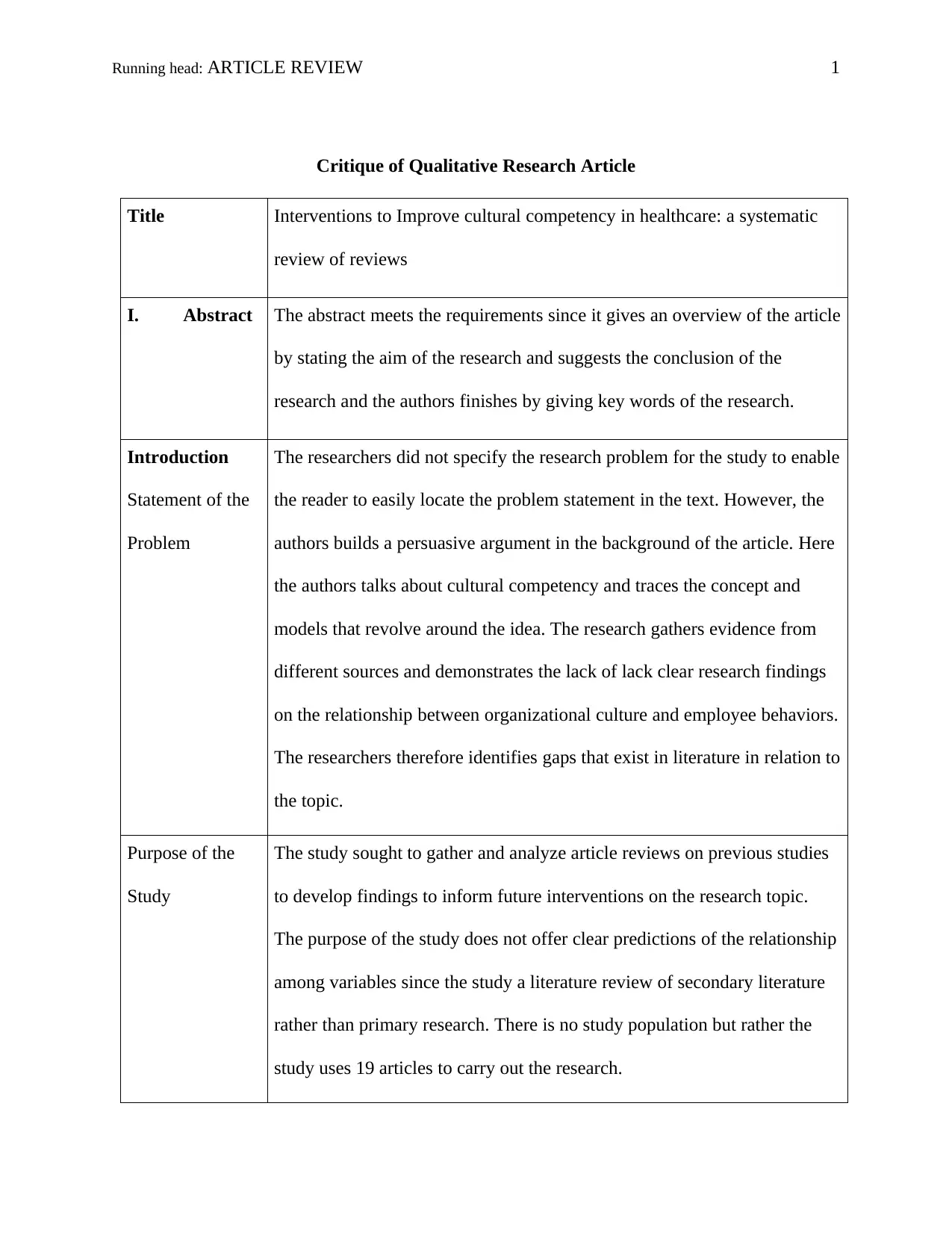
Running head: ARTICLE REVIEW 1
Critique of Qualitative Research Article
Title Interventions to Improve cultural competency in healthcare: a systematic
review of reviews
I. Abstract The abstract meets the requirements since it gives an overview of the article
by stating the aim of the research and suggests the conclusion of the
research and the authors finishes by giving key words of the research.
Introduction
Statement of the
Problem
The researchers did not specify the research problem for the study to enable
the reader to easily locate the problem statement in the text. However, the
authors builds a persuasive argument in the background of the article. Here
the authors talks about cultural competency and traces the concept and
models that revolve around the idea. The research gathers evidence from
different sources and demonstrates the lack of lack clear research findings
on the relationship between organizational culture and employee behaviors.
The researchers therefore identifies gaps that exist in literature in relation to
the topic.
Purpose of the
Study
The study sought to gather and analyze article reviews on previous studies
to develop findings to inform future interventions on the research topic.
The purpose of the study does not offer clear predictions of the relationship
among variables since the study a literature review of secondary literature
rather than primary research. There is no study population but rather the
study uses 19 articles to carry out the research.
Critique of Qualitative Research Article
Title Interventions to Improve cultural competency in healthcare: a systematic
review of reviews
I. Abstract The abstract meets the requirements since it gives an overview of the article
by stating the aim of the research and suggests the conclusion of the
research and the authors finishes by giving key words of the research.
Introduction
Statement of the
Problem
The researchers did not specify the research problem for the study to enable
the reader to easily locate the problem statement in the text. However, the
authors builds a persuasive argument in the background of the article. Here
the authors talks about cultural competency and traces the concept and
models that revolve around the idea. The research gathers evidence from
different sources and demonstrates the lack of lack clear research findings
on the relationship between organizational culture and employee behaviors.
The researchers therefore identifies gaps that exist in literature in relation to
the topic.
Purpose of the
Study
The study sought to gather and analyze article reviews on previous studies
to develop findings to inform future interventions on the research topic.
The purpose of the study does not offer clear predictions of the relationship
among variables since the study a literature review of secondary literature
rather than primary research. There is no study population but rather the
study uses 19 articles to carry out the research.
Paraphrase This Document
Need a fresh take? Get an instant paraphrase of this document with our AI Paraphraser
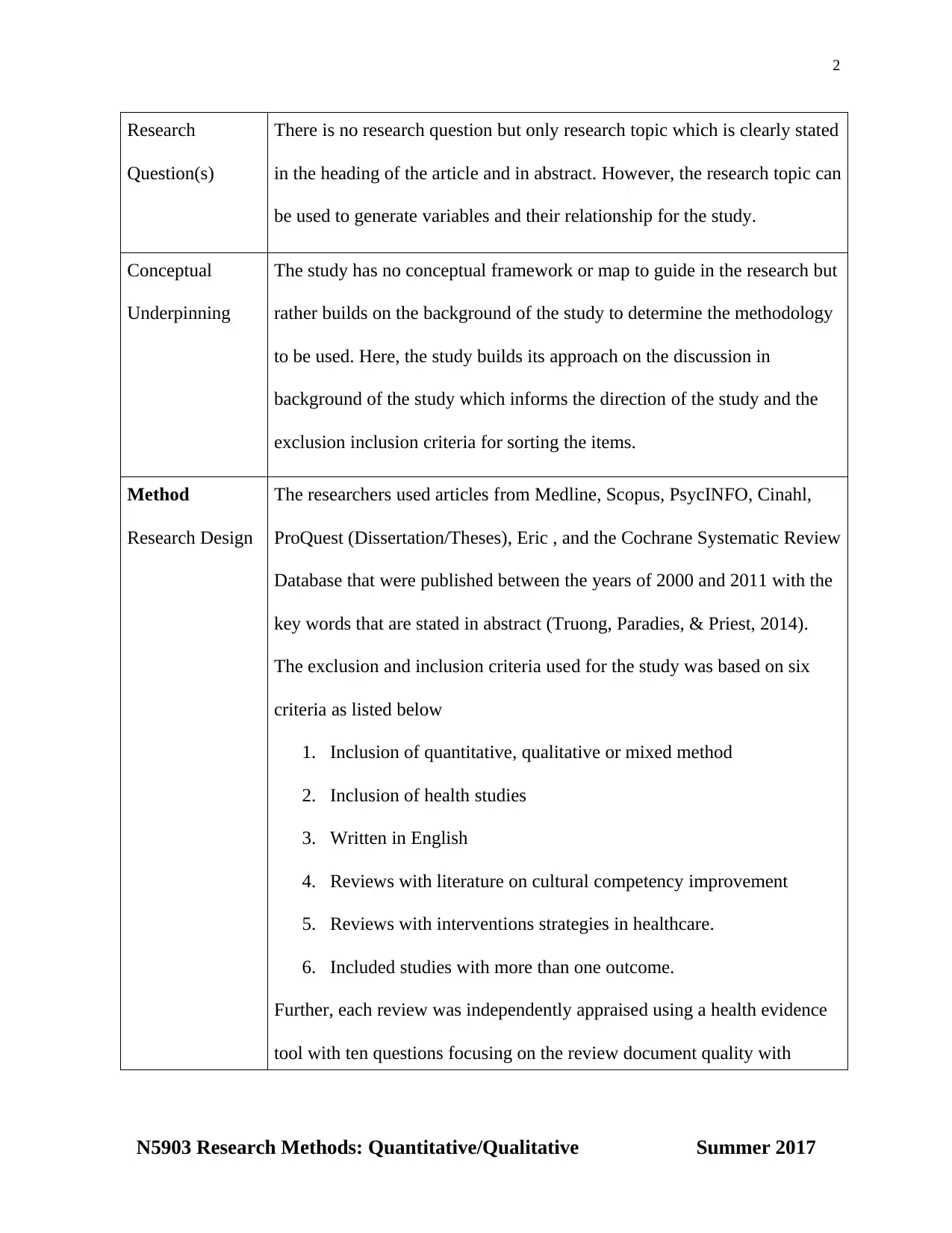
2
Research
Question(s)
There is no research question but only research topic which is clearly stated
in the heading of the article and in abstract. However, the research topic can
be used to generate variables and their relationship for the study.
Conceptual
Underpinning
The study has no conceptual framework or map to guide in the research but
rather builds on the background of the study to determine the methodology
to be used. Here, the study builds its approach on the discussion in
background of the study which informs the direction of the study and the
exclusion inclusion criteria for sorting the items.
Method
Research Design
The researchers used articles from Medline, Scopus, PsycINFO, Cinahl,
ProQuest (Dissertation/Theses), Eric , and the Cochrane Systematic Review
Database that were published between the years of 2000 and 2011 with the
key words that are stated in abstract (Truong, Paradies, & Priest, 2014).
The exclusion and inclusion criteria used for the study was based on six
criteria as listed below
1. Inclusion of quantitative, qualitative or mixed method
2. Inclusion of health studies
3. Written in English
4. Reviews with literature on cultural competency improvement
5. Reviews with interventions strategies in healthcare.
6. Included studies with more than one outcome.
Further, each review was independently appraised using a health evidence
tool with ten questions focusing on the review document quality with
N5903 Research Methods: Quantitative/Qualitative Summer 2017
Research
Question(s)
There is no research question but only research topic which is clearly stated
in the heading of the article and in abstract. However, the research topic can
be used to generate variables and their relationship for the study.
Conceptual
Underpinning
The study has no conceptual framework or map to guide in the research but
rather builds on the background of the study to determine the methodology
to be used. Here, the study builds its approach on the discussion in
background of the study which informs the direction of the study and the
exclusion inclusion criteria for sorting the items.
Method
Research Design
The researchers used articles from Medline, Scopus, PsycINFO, Cinahl,
ProQuest (Dissertation/Theses), Eric , and the Cochrane Systematic Review
Database that were published between the years of 2000 and 2011 with the
key words that are stated in abstract (Truong, Paradies, & Priest, 2014).
The exclusion and inclusion criteria used for the study was based on six
criteria as listed below
1. Inclusion of quantitative, qualitative or mixed method
2. Inclusion of health studies
3. Written in English
4. Reviews with literature on cultural competency improvement
5. Reviews with interventions strategies in healthcare.
6. Included studies with more than one outcome.
Further, each review was independently appraised using a health evidence
tool with ten questions focusing on the review document quality with
N5903 Research Methods: Quantitative/Qualitative Summer 2017
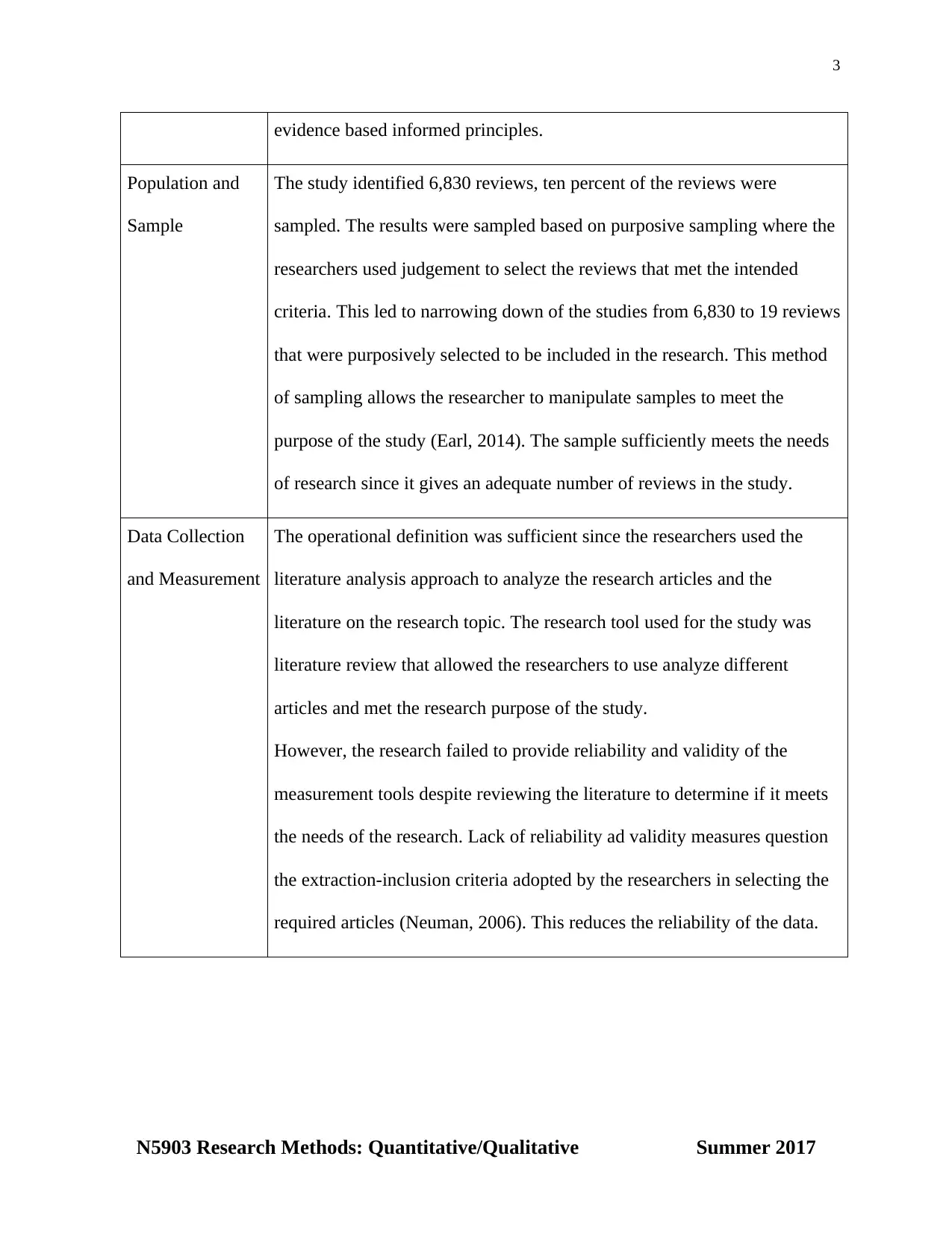
3
evidence based informed principles.
Population and
Sample
The study identified 6,830 reviews, ten percent of the reviews were
sampled. The results were sampled based on purposive sampling where the
researchers used judgement to select the reviews that met the intended
criteria. This led to narrowing down of the studies from 6,830 to 19 reviews
that were purposively selected to be included in the research. This method
of sampling allows the researcher to manipulate samples to meet the
purpose of the study (Earl, 2014). The sample sufficiently meets the needs
of research since it gives an adequate number of reviews in the study.
Data Collection
and Measurement
The operational definition was sufficient since the researchers used the
literature analysis approach to analyze the research articles and the
literature on the research topic. The research tool used for the study was
literature review that allowed the researchers to use analyze different
articles and met the research purpose of the study.
However, the research failed to provide reliability and validity of the
measurement tools despite reviewing the literature to determine if it meets
the needs of the research. Lack of reliability ad validity measures question
the extraction-inclusion criteria adopted by the researchers in selecting the
required articles (Neuman, 2006). This reduces the reliability of the data.
N5903 Research Methods: Quantitative/Qualitative Summer 2017
evidence based informed principles.
Population and
Sample
The study identified 6,830 reviews, ten percent of the reviews were
sampled. The results were sampled based on purposive sampling where the
researchers used judgement to select the reviews that met the intended
criteria. This led to narrowing down of the studies from 6,830 to 19 reviews
that were purposively selected to be included in the research. This method
of sampling allows the researcher to manipulate samples to meet the
purpose of the study (Earl, 2014). The sample sufficiently meets the needs
of research since it gives an adequate number of reviews in the study.
Data Collection
and Measurement
The operational definition was sufficient since the researchers used the
literature analysis approach to analyze the research articles and the
literature on the research topic. The research tool used for the study was
literature review that allowed the researchers to use analyze different
articles and met the research purpose of the study.
However, the research failed to provide reliability and validity of the
measurement tools despite reviewing the literature to determine if it meets
the needs of the research. Lack of reliability ad validity measures question
the extraction-inclusion criteria adopted by the researchers in selecting the
required articles (Neuman, 2006). This reduces the reliability of the data.
N5903 Research Methods: Quantitative/Qualitative Summer 2017
⊘ This is a preview!⊘
Do you want full access?
Subscribe today to unlock all pages.

Trusted by 1+ million students worldwide
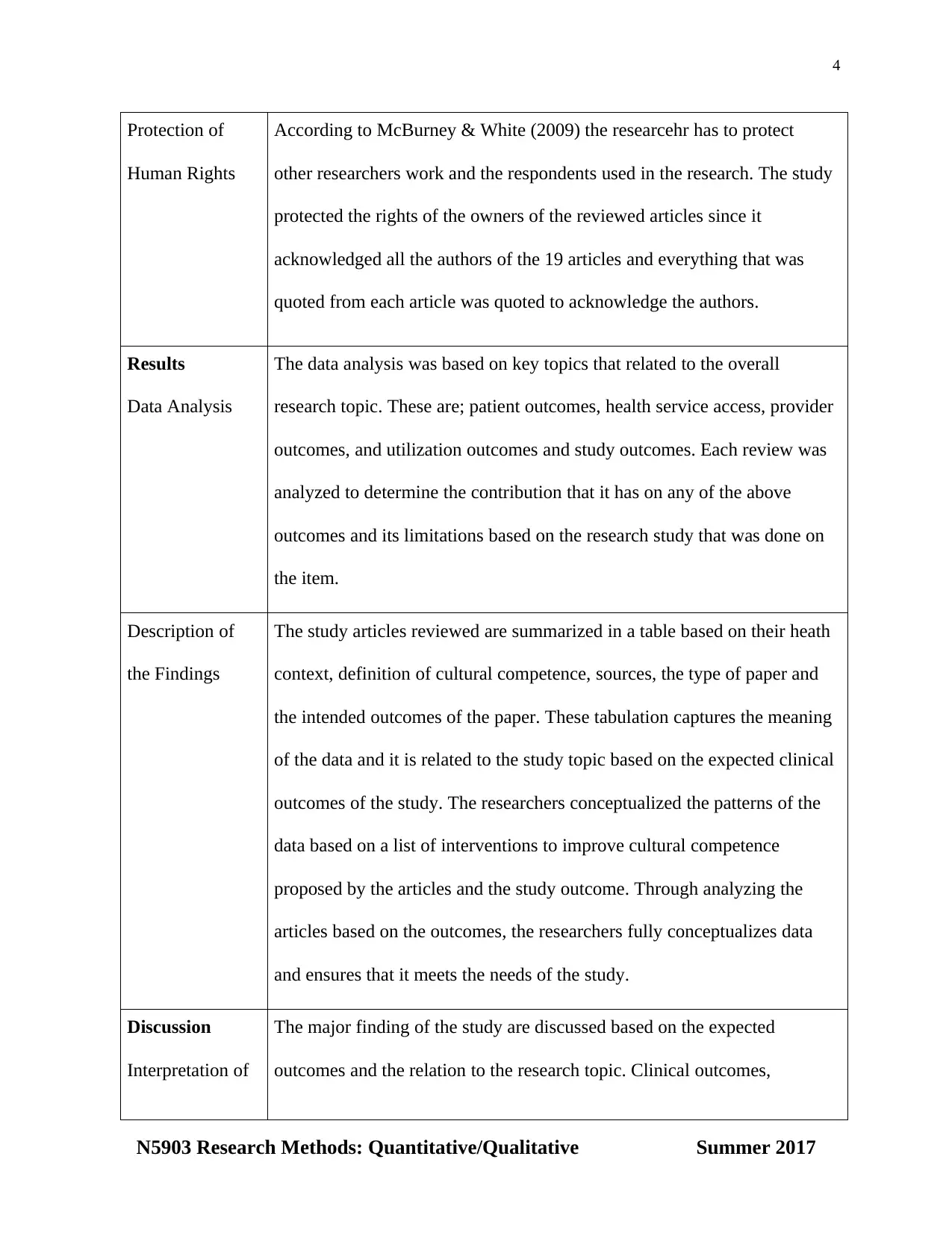
4
Protection of
Human Rights
According to McBurney & White (2009) the researcehr has to protect
other researchers work and the respondents used in the research. The study
protected the rights of the owners of the reviewed articles since it
acknowledged all the authors of the 19 articles and everything that was
quoted from each article was quoted to acknowledge the authors.
Results
Data Analysis
The data analysis was based on key topics that related to the overall
research topic. These are; patient outcomes, health service access, provider
outcomes, and utilization outcomes and study outcomes. Each review was
analyzed to determine the contribution that it has on any of the above
outcomes and its limitations based on the research study that was done on
the item.
Description of
the Findings
The study articles reviewed are summarized in a table based on their heath
context, definition of cultural competence, sources, the type of paper and
the intended outcomes of the paper. These tabulation captures the meaning
of the data and it is related to the study topic based on the expected clinical
outcomes of the study. The researchers conceptualized the patterns of the
data based on a list of interventions to improve cultural competence
proposed by the articles and the study outcome. Through analyzing the
articles based on the outcomes, the researchers fully conceptualizes data
and ensures that it meets the needs of the study.
Discussion
Interpretation of
The major finding of the study are discussed based on the expected
outcomes and the relation to the research topic. Clinical outcomes,
N5903 Research Methods: Quantitative/Qualitative Summer 2017
Protection of
Human Rights
According to McBurney & White (2009) the researcehr has to protect
other researchers work and the respondents used in the research. The study
protected the rights of the owners of the reviewed articles since it
acknowledged all the authors of the 19 articles and everything that was
quoted from each article was quoted to acknowledge the authors.
Results
Data Analysis
The data analysis was based on key topics that related to the overall
research topic. These are; patient outcomes, health service access, provider
outcomes, and utilization outcomes and study outcomes. Each review was
analyzed to determine the contribution that it has on any of the above
outcomes and its limitations based on the research study that was done on
the item.
Description of
the Findings
The study articles reviewed are summarized in a table based on their heath
context, definition of cultural competence, sources, the type of paper and
the intended outcomes of the paper. These tabulation captures the meaning
of the data and it is related to the study topic based on the expected clinical
outcomes of the study. The researchers conceptualized the patterns of the
data based on a list of interventions to improve cultural competence
proposed by the articles and the study outcome. Through analyzing the
articles based on the outcomes, the researchers fully conceptualizes data
and ensures that it meets the needs of the study.
Discussion
Interpretation of
The major finding of the study are discussed based on the expected
outcomes and the relation to the research topic. Clinical outcomes,
N5903 Research Methods: Quantitative/Qualitative Summer 2017
Paraphrase This Document
Need a fresh take? Get an instant paraphrase of this document with our AI Paraphraser
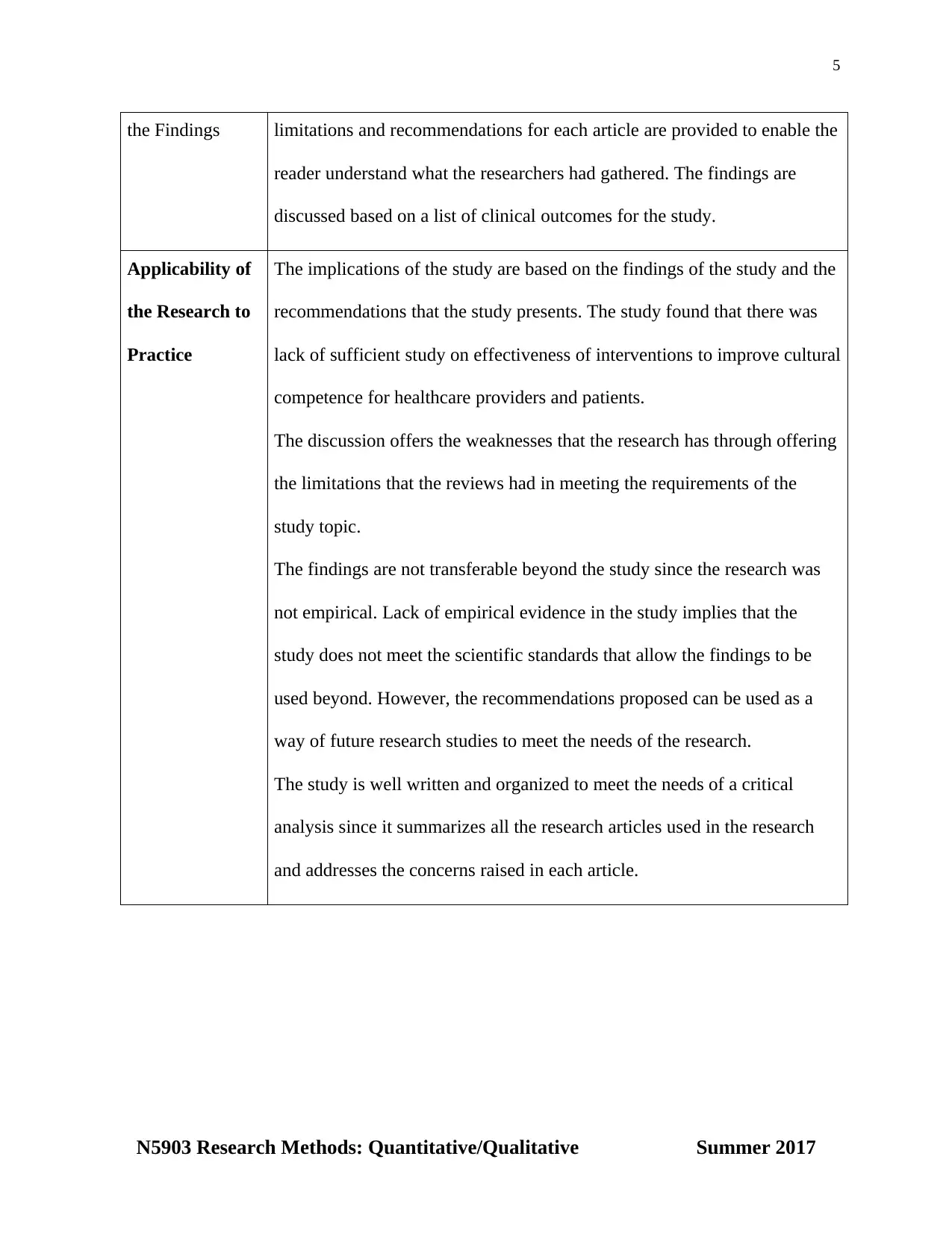
5
the Findings limitations and recommendations for each article are provided to enable the
reader understand what the researchers had gathered. The findings are
discussed based on a list of clinical outcomes for the study.
Applicability of
the Research to
Practice
The implications of the study are based on the findings of the study and the
recommendations that the study presents. The study found that there was
lack of sufficient study on effectiveness of interventions to improve cultural
competence for healthcare providers and patients.
The discussion offers the weaknesses that the research has through offering
the limitations that the reviews had in meeting the requirements of the
study topic.
The findings are not transferable beyond the study since the research was
not empirical. Lack of empirical evidence in the study implies that the
study does not meet the scientific standards that allow the findings to be
used beyond. However, the recommendations proposed can be used as a
way of future research studies to meet the needs of the research.
The study is well written and organized to meet the needs of a critical
analysis since it summarizes all the research articles used in the research
and addresses the concerns raised in each article.
N5903 Research Methods: Quantitative/Qualitative Summer 2017
the Findings limitations and recommendations for each article are provided to enable the
reader understand what the researchers had gathered. The findings are
discussed based on a list of clinical outcomes for the study.
Applicability of
the Research to
Practice
The implications of the study are based on the findings of the study and the
recommendations that the study presents. The study found that there was
lack of sufficient study on effectiveness of interventions to improve cultural
competence for healthcare providers and patients.
The discussion offers the weaknesses that the research has through offering
the limitations that the reviews had in meeting the requirements of the
study topic.
The findings are not transferable beyond the study since the research was
not empirical. Lack of empirical evidence in the study implies that the
study does not meet the scientific standards that allow the findings to be
used beyond. However, the recommendations proposed can be used as a
way of future research studies to meet the needs of the research.
The study is well written and organized to meet the needs of a critical
analysis since it summarizes all the research articles used in the research
and addresses the concerns raised in each article.
N5903 Research Methods: Quantitative/Qualitative Summer 2017
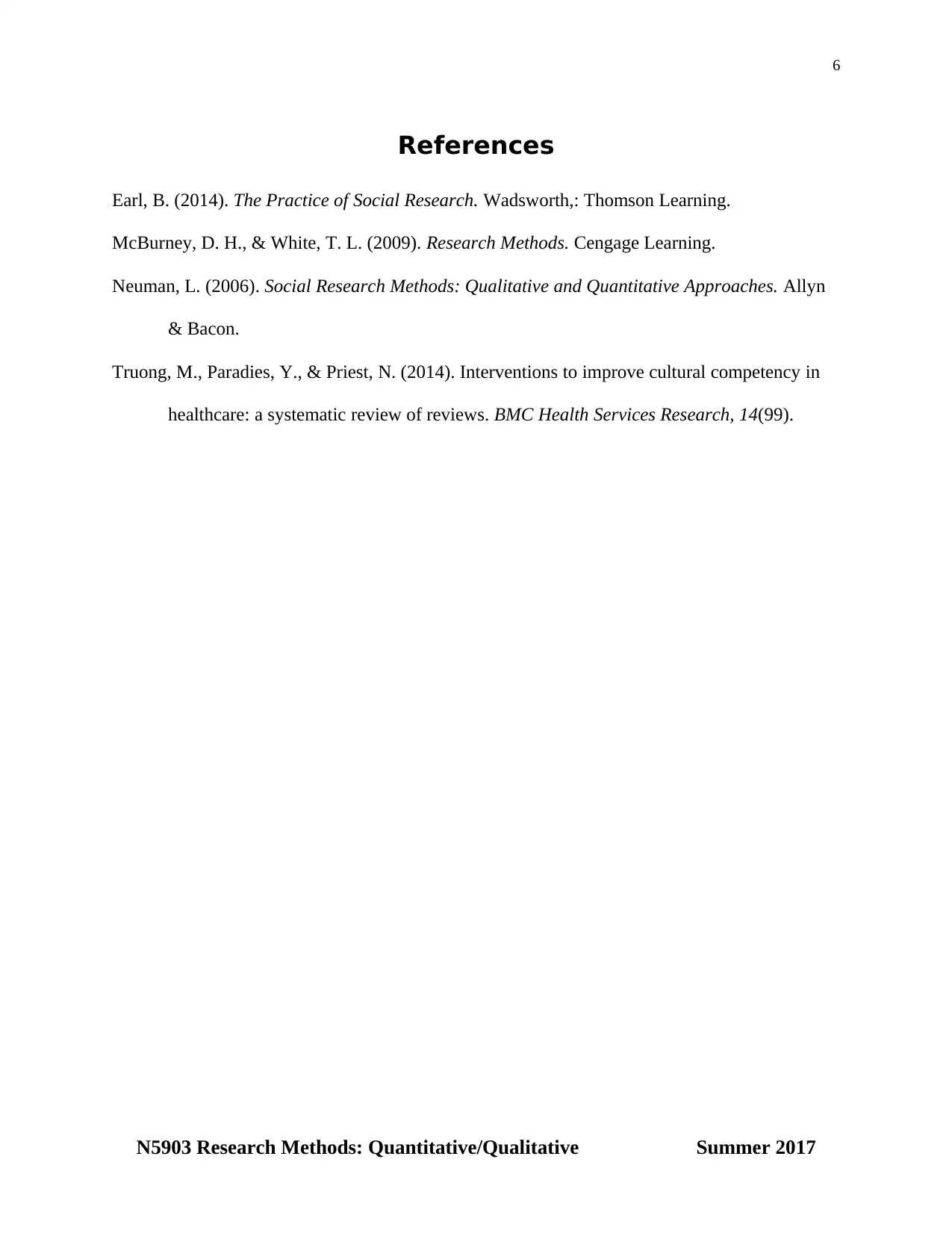
6
References
Earl, B. (2014). The Practice of Social Research. Wadsworth,: Thomson Learning.
McBurney, D. H., & White, T. L. (2009). Research Methods. Cengage Learning.
Neuman, L. (2006). Social Research Methods: Qualitative and Quantitative Approaches. Allyn
& Bacon.
Truong, M., Paradies, Y., & Priest, N. (2014). Interventions to improve cultural competency in
healthcare: a systematic review of reviews. BMC Health Services Research, 14(99).
N5903 Research Methods: Quantitative/Qualitative Summer 2017
References
Earl, B. (2014). The Practice of Social Research. Wadsworth,: Thomson Learning.
McBurney, D. H., & White, T. L. (2009). Research Methods. Cengage Learning.
Neuman, L. (2006). Social Research Methods: Qualitative and Quantitative Approaches. Allyn
& Bacon.
Truong, M., Paradies, Y., & Priest, N. (2014). Interventions to improve cultural competency in
healthcare: a systematic review of reviews. BMC Health Services Research, 14(99).
N5903 Research Methods: Quantitative/Qualitative Summer 2017
⊘ This is a preview!⊘
Do you want full access?
Subscribe today to unlock all pages.

Trusted by 1+ million students worldwide
1 out of 6
Related Documents
Your All-in-One AI-Powered Toolkit for Academic Success.
+13062052269
info@desklib.com
Available 24*7 on WhatsApp / Email
![[object Object]](/_next/static/media/star-bottom.7253800d.svg)
Unlock your academic potential
Copyright © 2020–2026 A2Z Services. All Rights Reserved. Developed and managed by ZUCOL.





